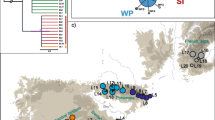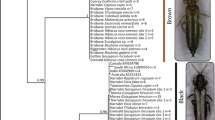Abstract
The brown tail moth (BTM) Euproctis chrysorrhoea (Linnaeus 1758) (Lepidoptera: Erebidae) is a forest and ornamental pest in Europe and the United States. Its extreme polyphagy, and documented phenological shift associated with host use suggest the presence of distinct host-races. To test this hypothesis, we sampled BTM infesting different host species in several locations along its distribution, and used DNA sequence data (a total of 1,672 bp from cytochrome c oxidase subunit I, elongation factor 1-alpha, and wingless) to produce haplotype networks and reconstruct the phylogenetic relationships between individuals. Population genetic diversity indices pointed out a higher genetic diversity in Europe, particularly in the samples from southern Spain and southern England. Lower F ST values were found between geographically closer populations when compared to more distant ones, but analyses of molecular variance and Mantel tests failed to reveal geographically associated genetic differentiation. However, haplotype networks and phylogenetic reconstructions revealed a previously unknown genetic differentiation within the BTM, with one lineage circumscribed to southern Europe. Although BTM haplotypes did not cluster according to their host plant, host-associated haplotypes were observed within certain geographic regions. Hence, our data support the existence of host-races of BTM within southern Spain and southern England, where populations from different hosts occur in sympatry.




Similar content being viewed by others
References
Avise JC, Neigel JE, Arnold J (1984) Demographic influences on mitochondrial DNA lineage survivorship in animal populations. J Mol Evol 20:99–105
Barbosa P, Schaefer PW (1997) Comparative analysis of patterns of invasion and spread of related lymantriids. In: Watt AD, Stork NE, Hunter MD (eds) Forests and insects. Chapman and Hall, London, pp 153–175
Barman AK, Parajulee MN, Sansone CG, Suh CPC, Medina RF (2012) Geographic pattern of host-associated differentiation in the cotton flea hopper, Pseudatomoscelis seriatus. Entomol Exp Appl 143:31–41
Behere GT, Tay WT, Russell DA, Heckel DG, Appleton BR, Kranthi KR, Batterham P (2007) Mitochondrial DNA analysis of field populations of Helicoverpa armigera (Lepidoptera: Noctuidae) and of its relationship to H. zea. BMC Evol Biol 7:117
Behere GT, Tay WT, Russell DA, Kranthi KR, Batterham P (2013) Population genetic structure of the cotton bollworm Helicoverpa armigera (Hübner) (Lepidoptera: Noctuidae) in India as inferred from EPIC-PCR DNA markers. PLoS ONE 8:e53448
Celikel G, Demirsoy L, Demirsoy H (2008) The strawberry tree (Arbutus unedo L.) selection in Turkey. Sci Hortic 118:115–119
Cho Y, Park JS, Kim MJ, Choi D-S, Nam S-H, Kim I (2013) Genetic relationships between Mt. Halla and Mongolian populations of Hipparchia autonoe (Lepidoptera: Nymphalidae). Entomol Res 43:183–192
Clement M, Posada D, Crandall KA (2000) TCS: a computer program to estimate gene genealogies. Mol Ecol 9:1657–1659
Coyne JA, Orr HA (2004) Speciation. Sinauer, Sunderland
Dambroski H, Feder JL (2007) Host plant and latitude-related diapause variation in Rhagoletis pomonella: a test for multifaceted life history adaptation on different stages of diapause development. J Evol Biol 20:2101–2112
Delrio G, Luciano P (1985) The parasites and predators of Euproctis chrysorrhoea L. in Sardinia (preliminary note). In: Atti XIV Congresso Nazionale Italiano di Entomologia Sotto Gli Auspici dell’Accademia Nazionale Italiana di Entomologia. Della Società Entomologica Italiana e Della International Union of Biological Sciences, Palermo, Italy, 28 May–1 June, 1985
Drès M, Mallet J (2002) Host races in plant-feeding insects and their importance in sympatric speciation. Philos Trans R Soc B 357:471–492
Elkinton JS, Parry D, Boettner GH (2006) Implicating an introduced generalist parasitoid in the invasive browntail moth’s enigmatic demise. Ecology 87:2664–2672
Elkinton JS, Preisser E, Boettner G, Parry D (2008) Factors influencing larval survival of the invasive browntail moth (Lepidoptera: Lymantriidae) in relict North American populations. Environ Entomol 37:1429–1437
Excoffier L, Lischer HEL (2010) Arlequin suite ver. 3.5: a new series of programs to perform population genetics analyses under Linux and Windows. Mol Ecol Resour 10:564–567
Forestry Compendium (2005) Euproctis chrysorrhoea L. (Lepidoptera: Lymantriidae) Datasheet. CAB International, Wallingford, Connecticut. http://www.cabi.org/compendia/fc/
Frago E, Selfa J, Pujade-Villar J, Guara M, Bauce É (2009) Age and size thresholds for pupation and developmental polymorphism in the browntail moth, Euproctis chrysorrhoea under conditions that either emulate diapause or prevent it. J Insect Physiol 55:952–958
Frago E, Guara M, Pujade-Villar J, Selfa J (2010) Winter feeding leads to a shifted phenology in the browntail moth Euproctis chrysorrhoea on the evergreen strawberry tree Arbutus unedo. Agric For Entomol 12:381–388
Futuyma DJ (2008) Sympatric speciation: norm or exception? In: Tilmon KJ (ed) Evolutionary biology of herbivorous insects. University of California Press, Berkley, pp 136–148
Geiselhardt S, Otte T, Hilker M (2012) Looking for a similar partner: host plants shape mating preferences of herbivorous insects by altering their contact pheromones. Ecol Lett 15:971–977
Gómez A, Lunt DH (2006) Refugia within refugia: patterns of phylogeographic concordance in the Iberian Peninsula. In: Weiss S, Ferrand N (eds) Phylogeography of Southern European. Springer, Dordrecht, pp 155–188
Gratton P, Konopinski MK, Sbordoni V (2008) Pleistocene evolutionary history of the Clouded Apollo (Parnassius mnemosyne): genetic signatures of climate cycles and a ‘time-dependent’ mitochondrial substitution rate. Mol Ecol 17:4248–4262
Hammouti N, Schmitt T, Seitz A, Kosuch J, Veith M (2010) Combining mitochondrial and nuclear evidences: a refined evolutionary history of Erebia medusa (Lepidoptera: Nymphalidae: Satyrinae) in Central Europe based on the CO1 gene. J Zool Syst Evol Res 48:115–125
Hebert PDN, Penton EH, Burns JM, Janzen DH, Hallwachs W (2004) Ten species in one: DNA barcoding reveals cryptic species in the neotropical skipper butterfly Astraptes fulgerator. Proc Natl Acad Sci 101:14812–14817
Hewitt GM (2001) Speciation, hybrid zones and phylogeography—or seeing genes in space and time. Mol Ecol 10:537–549
Howard LO, Fiske WF (1911) The importation into the United States of the parasites of the gipsy moth and the browntail moth, vol 91. USDA Bureau of Entomology Bulletin, Washington
Imo M, Maixner M, Johannesen J (2013) Sympatric diversification vs. immigration: deciphering host-plant specialization in a polyphagous insect, the stolbur phytoplasma vector Hyalesthes obsoletus (Cixiidae). Mol Ecol 22:2188–2203
Jallow MFA, Cunningham JP, Zalucki MP (2004) Intra-specific variation for host plant use in Helicoverpa armigera (Hübner) (Lepidoptera: Noctuidae): implications for management. Crop Prot 23:955–964
Janz N (2011) Ehrlich and Raven revisited: mechanisms underlying codiversification of plants and enemies. Annu Rev Ecol Evol Syst 42:71–89
Janz N, Nylin S (2008) The oscillation hypothesis of host-plant range and speciation. In: Tilmon KJ (ed) Specialization, speciation, and radiation: the evolutionary biology of herbivorous insects. University of California Press, Berkeley, pp 203–215
Janz N, Nylin S, Wahlberg N (2006) Diversity begets diversity: host expansions and the diversification of plant-feeding insects. BMC Evol Biol 6:4
Jensen JL, Bohonak AJ, Kelley ST (2005) Isolation by distance v.3.23, web service. BMC Genetics 6:13. http://ibdws.sdsu.edu/. Accessed Sept 2013)
Kajtoch Ł, Kubisz D, Gutowski JM, Babik W (2013) Evolutionary units of Coraebus elatus (Coleoptera: Buprestidae) in central and eastern Europe—implications for origin and conservation. Insect Conserv Divers. doi:10.1111/icad.12031
Lanfear R, Calcott B, Ho SYW, Guindon S (2012) PartitionFinder: combined selection of partitioning schemes and substitution models for phylogenetic analyses. Mol Biol Evol 29:1695–1701
Lo Verde G, Massa B (1995) Euproctis chrysorrhoea (L.) (Lepidoptera: Lymantriidae) and Phytomyza phillyreae Hering (Diptera: Agromyzidae) in the Mediterranean maquis of Pantelleria: biological data and parasitoids. Nat Sicil 19:679–691
Nei M (1987) Molecular evolutionary genetics. Columbia University Press, New York
Norgate M, Chamings J, Pavlova A, Bull JK, Murray ND, Sunnucks P (2009) Mitochondrial DNA indicates late Pleistocene divergence of populations of Heteronympha merope, an emerging model in environmental change biology. PLoS ONE 4:e7950
Özcan M, Haciseferogullari H (2007) The strawberry (Arbutus unedo L.) fruits: chemical composition, physical properties and mineral contents. J Food Eng 78:1022–1028
Porreta D, Canestrelli D, Bellini R, Celli G, Urbanelli S (2007) Improving insect pest management through population genetic data: a case study of the mosquito Ochlerotatus caspius (Pallas). J Appl Ecol 44:682–691
Raymond M, Rousset F (1995) An exact test for population differentiation. Evolution 49:1280–1283
Ronquist F, Huelsenbeck JP (2003) MrBayes 3: Bayesian phylogenetic inference under mixed models. Bioinformatics 19:1572–1574
Santos H, Burban C, Rousselet J, Rossi J-P, Branco M, Kerdelhué C (2011) Incipient allochronic speciation in the pine processionary moth (Thaumetopoea pityocampa, Lepidoptera, Notodontidae). J Evol Biol 24:146–158
Schaefer PW (1974) Population ecology of the browntail moth (Euproctis chrysorrhoea L.) (Lepidoptera: Lymantriidae) in North America. PhD dissertation, University of Maine
Schmitt T, Varga Z (2012) Extra-mediterranean refugia: the rule and not the exception? Front Zool 9:22
Sharon G, Segal D, Ringo JM, Hefez A, Zilber-Rosenberg I, Rosenberg E (2010) Commensal bacteria play a role in mating preference of Drosophila melanogaster. Proc Natl Acad Sci 107:20051–20056
Silva-Brandão KL, Lyra ML, Freitas AVL (2009) Barcoding Lepidoptera: current situation and perspectives on the usefulness of a contentious technique. Neotrop Entomol 38:441–451
Smadja C, Butlin RK (2011) A framework for comparing processes of speciation in the presence of gene flow. Mol Ecol 20:5123–5140
Sokal RR, Rohlf FJ (1995) Biometry: the principles and practice of statistics in biological research. W.H. Freeman and Company, New York
Stewart JR, Lister AM (2001) Cryptic northern refugia and the origins of modern biota. Trends Ecol Evol 16:608–613
Stewart JR, Lister AM, Barnes I, Dalén L (2010) Refugia revisited: individualistic responses of species in space and time. Proc R Soc B 277:661–671
Stireman JO III, Nason JD, Heard SB (2005) Host-associated genetic differentiation in phytophagous insects: general phenomenon or isolated exceptions? Evidence from a Goldenrod-insect community. Evolution 12:2573–2587
Svensson GP, Althof DM, Pellmyr O (2005) Replicated host-race formation in bogus yucca moths: genetic and ecological divergence of Prodoxus quinquepunctellus on yucca hosts. Evol Ecol Res 7:1139–1151
Tajima F (1989) The effect of change in population size on DNA polymorphism. Genetics 123:585–595
van Nieukerken EJ, Doorenweerd C, Stokvis FR, Groenenberg DSJ (2012) DNA barcoding of the leaf-mining moth subgenus Ectoedemia s. str. (Lepidoptera: Nepticulidae) with COI and EF1-α: two are better than one in recognizing cryptic species. Contrib Zool 81:1–24
Wahlberg N, Wheat CW (2008) Genomic outposts serve the phylogenomic pioneers: designing novel nuclear markers for genomic DNA extractions of Lepidoptera. Syst Biol 57:231–242
Webster SE, Galindo J, Grahame JW, Butlin RK (2012) Habitat choice and speciation. Int J Ecol 154686
Wilson JJ (2010) Assessing the value of DNA barcodes and other priority gene regions for molecular phylogenetics of Lepidoptera. PLoS ONE 5:e10525
Wright S (1943) Isolation by distance. Genetics 28:114–138
Zwickl DJ (2006) Genetic algorithm approaches for the phylogenetic analysis of large biological sequence datasets under the maximum likelihood criterion. PhD dissertation, University of Texas, Austin
Acknowledgments
The authors would like to thanks the following persons for kindly sending samples from different BTM populations: Josep-Maria Riva (Menorca, Spain), Constantin Ciornei and Raoul Constantineanu (Romania), Jean-Pierre Allanioux (France), Jeff Boettner and Joe Elkinton (USA) and Hugo Mas and Eduardo Perez-Laorga (València, Spain). The authors also thank Roger Gwazdowski and Andrew Frewin for advice on haplotype network editing and formatting, and the Editor in Chief Professor John Endler, the Associate Editor Dr Arjen Biere, and two anonymous Reviewers for all their comments, corrections and suggestions that contributed for a better version of this paper. This study was supported by the Carl Tryggers Foundation and the Royal Physiographic Society in Lund, Sweden.
Author information
Authors and Affiliations
Corresponding author
Electronic supplementary material
Below is the link to the electronic supplementary material.
Rights and permissions
About this article
Cite this article
Marques, J.F., Wang, HL., Svensson, G.P. et al. Genetic divergence and evidence for sympatric host-races in the highly polyphagous brown tail moth, Euproctis chrysorrhoea (Lepidoptera: Erebidae). Evol Ecol 28, 829–848 (2014). https://doi.org/10.1007/s10682-014-9701-3
Received:
Accepted:
Published:
Issue Date:
DOI: https://doi.org/10.1007/s10682-014-9701-3




